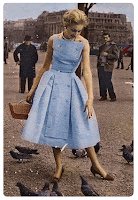I'm beginning to think that life is just a series of coincidences - one event/decision/action leads to an apparently unrelated event/decision/action, which leads to another and so on, until all those little things add up to one big thing. Here's how my recent series is connected:

.JPG)
For nearly a year I have been reading
Coco's Loft. A fabulous and talented lady who makes the most outstanding clothes and has really defined her style. Many of her photo shoots are in her garden. My fingers are definitely NOT green, I can kill weeds, but Coco's garden is tropical, lush and very, very green. Every time I see it I tend to look at the plants and not the dress (sorry Coco).


Then Elizabeth, from
Sewn, was fixated for a while on a Burda batwing top and made some beautiful versions, each a little different from the last. I actually have this pattern too, being one of the few that I managed to trace off and know her addiction well. I also made 3 or 4. It's an easy pattern, front and back cut on the fold with a bit of bias or other finishing technique around the neck, sleeves and hem. Recently she also posted about
hating to cut out, have I got a treat for her!
Next, I set a
puzzle pattern piece for you to guess what it would morph into. I inadvertently posted a photo of the pattern and
The Centre for Pattern Design told me off, in case some unscrupulous sewer copied the design from my blog. I promptly removed the image and for my efforts, CPD very, very kindly gifted another pattern. I also suspect that they received considerably more orders for patterns that week.
I've also been reading around the blog-o-sphere of
Fearless February. A personal challenge to settle down and tackle those sewing related things that you '
need a bit more practice' at. While not officially signing up, the challenge did spark something in me. So things I'm really crap at - sewing in a straight line; applying bias binding without wrinkles; sewing an even distance from the edge; good top stitching, and stitch-in-the-ditch. Ironically, I used most of these techniques in the recently completed
raincoat but I've seen it up close and believe me, there's lots of room for improvement.
Bear with me, we're getting there.........that's four stories so far.

While in town the other day, the one and only fabric shop had a table set up with a selection of cottons at half price. Most were end of rolls but generally 1 -2m in length. All sorts of colours and patterns but I was drawn to a grey/green leaf design.
My immediate thought was -
Coco's garden!

Then the pattern arrived in the post (air mail no less),
MV bias cut top. Wait for it.....one piece!
My immediate thought was -
Elizabeth would love this: batwing style and easy to cut out!
And so, we are now at the point of culmination of all these coincidences to proudly present the Centre for Pattern Design's Madeleine Vinonnet's inspired bias cut top-

And so we come to then end (so far) of this series of fortunate events...or do you have any to add?
I've practiced my top stitching and stitching in the ditches, attaching bias binding in lots of different ways, and discovered a top that has one pattern piece that is cut on the bias with only 2 seams (count them, two!), drapes beautifully to the body without being clingy and can be made in almost any fabric.
The pattern comes in small, medium and large but without SAs. I started with the L but have added 1cm on every subsequent cut. The fit on Number 2 and 3 is much better than the Number 1 satin. Just check the width of the bottom of the sleeves - too tight and you'll end up with a T-shirt like me! You'll need about 1.5m of fabric and the wider the better, especially of you want longer sleeves. The excess fabric at the end can be used very productively for making the bias binding.
Most batwing tops are difficult to wear under a cardigan or jacket without the sleeves all bunching up but this top has narrower sleeves and easily fits comfortably underneath a cardi.
Do you have any strange coincidence stories, or a train of events that led you to where you are now?
 I started with McCalls 6068 (OOP) but as you can see is it unfitted. It's a great little basic shirt pattern with easy collar, cuffs and the two-piece sleeves make for an easy vent too.
I started with McCalls 6068 (OOP) but as you can see is it unfitted. It's a great little basic shirt pattern with easy collar, cuffs and the two-piece sleeves make for an easy vent too.



























